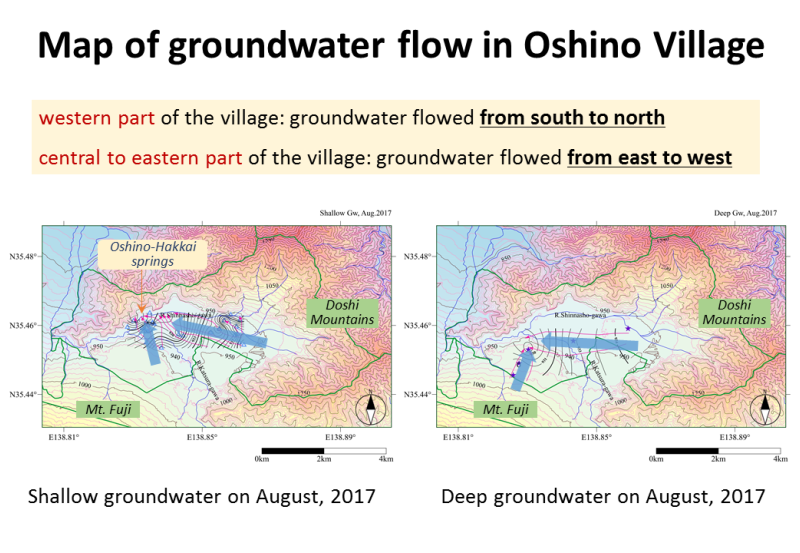
Water quality characteristics and dynamics of groundwater and spring water revealed by multi-tracers in Oshino, Yamanashi, Japan
ABSTRACT

Observations in Oshino Village, Yamanashi Prefecture, Japan were conducted in January and August, 2017, and the water quality characteristics of the shallow and deep groundwater and spring water were elucidated. The water quality of the area’s shallow groundwater indicated the presence of relatively high levels of Ca-HCO3, Mg2+, and SO42– at some sites, and the deep groundwater contained Ca-HCO3, (Ca+Na)-HCO3, (Ca+Mg)-HCO3, and Na-HCO3. In August, the shallow groundwater at some sites was mixed with irrigation and paddy water affected by evaporation and fertilization. In deep groundwater, δ18O and δ2H levels were lower than those in shallow groundwater; therefore, the recharge area of deep groundwater probably increased as a result of elevation. The dissolved matter contents and isotope ratios of Deguchi-ike, which is one of the Oshino-Hakkai springs, were different from those of other Oshino-Hakkai springs, which may have been caused by differences in the recharge elevation. The vanadium and phosphorus concentrations of deep groundwater were relatively higher than those of the shallow groundwater and spring water, which may be ascribed to the influence of the basaltic rock of Mt. Fuji. Additionally, the observation of the groundwater level revealed two regional groundwater flow systems in Oshino Village: one flowed from south to north in the western part of the village, and the other flowed from east to west in the central to eastern part of the village. The former corresponded to a flow from Mt. Fuji to Oshino-Hakkai, and the latter to that from the Doshi Mountains to near Oshino-Hakkai.
KEYWORDS
Oshino Village, Ohino-Hakkai springs, water quality, groundwater flow, Mt. FujiSupplementary Materials(file)
https://www.jstage.jst.go.jp/article/geochemj/57/1/57_GJ23003/_supplement/_download/57_GJ23003_1.pdf
- Published : 2023
- Released on J-STAGE : 2023/02/23
- Received : 2022/08/16
- Accepted : 2023/01/08
- DOI : https://doi.org/10.2343/geochemj.GJ23003
- J-STAGE URL : https://www.jstage.jst.go.jp/article/geochemj/57/1/57_GJ23003/_article/-char/en
- J-Online ISSN: 1880-5973
- Print ISSN : 0016-7002
- ISSN-L : 0016-7002
All Issues
- Vol.59, 2025
- Vol.58, 2024
- Vol.57, 2023
- Vol.56, 2022
- Vol.55, 2021
- Vol.54, 2020
- Vol.53, 2019
- Vol.52, 2018
- Vol.51, 2017
- Vol.50, 2016
- Vol.49, 2015
- Vol.48, 2014
- Vol.47, 2013
- Vol.46, 2012
- Vol.45, 2011
- Vol.44, 2010
- Vol.43, 2009
- Vol.42, 2008
- Vol.41, 2007
- Vol.40, 2006
- Vol.39, 2005
- Vol.38, 2004
- Vol.37, 2003
- Vol.36, 2002
- Vol.35, 2001
- Vol.34, 2000
- Vol.33, 1999
- Vol.32, 1998
- Vol.31, 1997
- Vol.30, 1996
- Vol.29, 1995
- Vol.28, 1994
- Vol.27, 1993
- Vol.26, 1992
- Vol.25, 1991
- Vol.24, 1990
- Vol.23, 1989
- Vol.22, 1988
- Vol.21, 1987
- Vol.20, 1986
- Vol.19, 1985-1986
- Vol.18, 1984
- Vol.17, 1983
- Vol.16, 1982
- Vol.15, 1981
- Vol.14, 1980
- Vol.13, 1979
- Vol.12, 1978
- Vol.11, 1977
- Vol.10, 1976
- Vol.9, 1975
- Vol.8, 1974
- Vol.7, 1973
- Vol.6, 1972-1973
- Vol.5, 1971
- Vol.4, 1970-1971
- Vol.3, 1969-1970
- Vol.2, 1968
- Vol.1, 1966-1967




